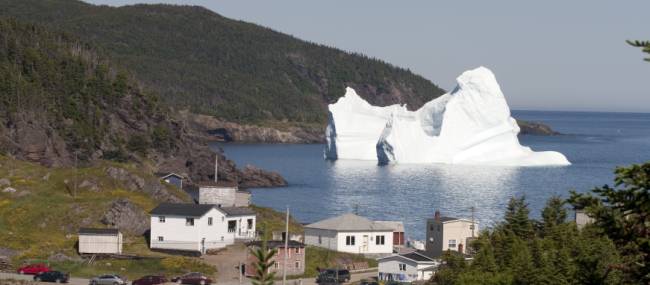
A giant iceberg visits a tiny coastal community | Newfoundland and Labrador Tourism
By Robin Esrock
We all know what icebergs are, what they look like, and how they play a distinctive role in overused idioms and morality tales about unsinkable ships. Less known is the exhilaration and goosebump-inducing experience accompanying the sighting of a real iceberg for the very first time.
One can't help but feel a visceral and emotional response to any building-sized chunk of ice, ebbing with the ocean currents, shaped by the winds and sea. Icebergs are often much bigger and more imposing than expected, rising up to 60 metres above the water. It's even more impressive when you consider that ninety percent of the ice sits below the ocean surface (hence all we see is the tip of the iceberg). Delicately carved by nature and glistening with glacial hues of white, turquoise, purple and blue, the ice sculptures are beautiful to behold.

One of many Newfoundland's East Coast Trail draws is an opportunity to see migrating icebergs as you make your way along coastal stretches. Nobody knows exactly how big each season's icebergs will be, where they might show up or how close to the shoreline they will stray, but there is a handy user-generated Iceberg Tracker to give you some idea. While weather is a major factor, Newfoundland's iceberg season typically kicks off in April and lasts until early summer, peaking in May and June.
The best icebergs are those that reach less than five kilometres from the coast, requiring neither a zoom lens nor binoculars. And this is not uncommon, which is why iceberg tourism in Newfoundland is a major attraction. Tour operators run daily boat trips out of St John's and, more popularly, from Twillingate, a small town also known as Iceberg Alley. Located about a 5–6-hour drive from St John's, the town receives regular icebergs on their long journey from the Arctic or Greenland. Hikers, meanwhile, might see them on several popular sections of the East Coast Trail, such as the:
- Cape Spear Path: located at the easternmost point of North America, this rugged section of the trail is an ideal spot to see icebergs patrolling offshore.
- Blackhead Path: treading atop the ocean cliffs, panorama views of the Atlantic often present both migrating icebergs and whales.
- La Manche Village Path: this coastal trek takes you to a historic abandoned village and suspension bridge, with iceberg viewing opportunities in the distance.
- Spurwink Island Path: this challenging section of the trail delivers sweet coastal views, so remember to keep your eyes on the trail and the water.

The cold Labrador Current that originates in the Arctic shepherds icebergs to both the north and west coast of Newfoundland. The town of St. Anthony, known as the Iceberg Capital of the World, offers boat tours that get you safely up close and personal to the bergs, with ample wildlife viewing opportunities along the way. On Great Canadian Trail's Vikings, Whales and Iceberg itinerary, definitely keep an eye out for icebergs from the shores of historic L'Anse Aux Meadows, and you won't find a better spot for iceberg viewing than Quirpon Island. Accessed only by boat, this fully restored lighthouse keeper's inn is located on the island's northernmost tip, directly in the path of frozen visitors on their journey south. With the longest iceberg viewing season in Newfoundland, the rugged coast of Quirpon Island still greets icebergs as late as summer and into the fall. But where exactly do they come from?

Icebergs are created through a process known as calving, as chunks of ice break off from the edges of glaciers or ice shelves into the surrounding ocean. This is some of the purest water you'll find anywhere on Earth, untainted by human activity, compacted and frozen over thousands of years. Here's another reason iceberg water is so highly regarded, with huge chunks harvested every year and finding their way into different products. In Newfoundland, you'll find Iceberg Vodka (produced by a distillery owned by the Newfoundland government), Auk Island's blueberry iceberg wine, and the fantastically crisp Iceberg Lager, produced by the Quidi Vidi Brewery (look for the distinctive dark blue glass bottle).

Trapped air bubbles in the ice provide valuable information about our climate millennia ago and, along with age, contribute to the berg's different colour. Most icebergs are brilliant white since pure ice reflects all light. Dense icebergs with few air bubbles appear crystal blue, and seawater and weather conditions might result in a spectrum of colour. Any brown or black markings suggest run-ins with land or dirt collected from its glacier days.
If you're lucky enough to haul out a small 'bergie bit' that has broken up and floated close to a beach, you'll find the ice thick and incredibly heavy. As the locals refer to them, each seasonal' visitor' will eventually melt, break down against the elements, or smash apart into coastal rocks or seabed. Warming temperatures mean more ice sheets and glaciers are carving into the oceans, which is expected to raise global sea levels significantly. Just how much ice are we talking about? In 2000, a single iceberg carved from the Ross Shelf in Antarctica was measured to be roughly the size of Jamaica! Since then, it has broken down along the coastline, and only a small portion remains.

Whether taking on the East Coast Trail or heading north to Quirpon Island, you'll be weaving together the best attractions of Newfoundland: scenic beauty, wonderful culture, fascinating history, incredible seafood, and the opportunity to see an icy marvel on its annual pilgrimage south. Everyone knows what an iceberg is, and by visiting Newfoundland, you'll finally know what it's like to actually see one.
Robin Esrock is a renowned travel journalist and the bestselling author of the Great Canadian Bucket List.